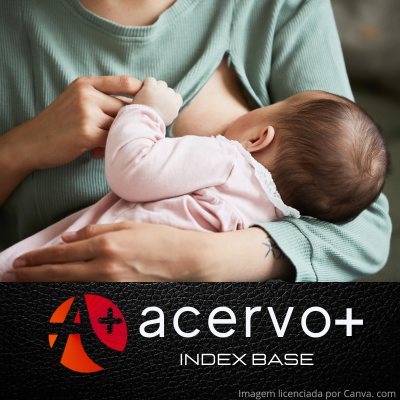Mudanças na rotina advindas da COVID-19 e associações com desfechos de desenvolvimento de lactentes de 18 a 24 meses
##plugins.themes.bootstrap3.article.main##
Resumo
Objetivo: Correlacionar os resultados obtidos nos domínios motor e de linguagem, e identificar aspectos da rotina potencialmente modificados pela pandemia e nos desfechos de desenvolvimento. Métodos: Estudo transversal analítico que avaliou lactentes neurotípicos de 18 a 24 meses, nascidos à termo por meio da Bayley Scales of Infant and Toddler Development®-III. Resultados: A comunicação receptiva (CR) apresentou correlação positiva com a jornada de trabalho fixa das mães, convívio com ambos os pais, e com o interesse dos pais em buscarem a pesquisa para a avaliação de seus filhos. Porém, negativou com um maior “Tempo de TV”. A Comunicação Expressiva (CE) correlacionou-se com uma maior renda familiar e com “Busca pela pesquisa”. A variável Linguagem (LGG=CR+CE), acrescentou correlações positivas com uma maior “Escolaridade Paterna” e com o fato de o lactente engatinhar (p = 0,040). No domínio motor, a Escala Motora Fina (Mot F) correlacionou-se com maior renda familiar, enquanto a Motora Grossa (Mot G) apresentou correlação negativa com o número de pessoas residindo na mesma casa e o estresse gestacional em razão da Pandemia. Conclusão: As rotinas modificadas pelo contexto pandêmico correlacionam-se com os marcadores de desenvolvimento infantil, principalmente relacionados à linguagem.
##plugins.themes.bootstrap3.article.details##
Copyright © | Todos os direitos reservados.
A revista detém os direitos autorais exclusivos de publicação deste artigo nos termos da lei 9610/98.
Reprodução parcial
É livre o uso de partes do texto, figuras e questionário do artigo, sendo obrigatória a citação dos autores e revista.
Reprodução total
É expressamente proibida, devendo ser autorizada pela revista.
Referências
2. GAYTHORPE KAM, et al. Infantren’s role in the COVID‑19 pandemic: a systematic review of early surveillance data on susceptibility, severity, and transmissibility. Scientific Reports, 2021;11:13903.
3. DIAMOND G e MERRICK J. Editorial: Infantren’s neurodevelopment in the post-COVID era: From hospital to community. Pediatrics. 2022;10:976884.
4. CLARK H, et al. After COVID-19, a future for the world’s infantren? The Lancet, 2020;396(10247):298-300.
5. ALVES RA, et al. Fique em casa? Remoções forçadas e COVID-19. Revista Direito e Práxis, 2021;12:2141-73.
6. STAFFSTROM CE. Neurological effects of COVID-19 in infants and infantren. Dev Med Infant Neurol, 2022;64:818-29.
7. ARAÚJO LA de, et al. The potential impact of the COVID-19 pandemic on infant growth and development: a systematic review. Jornal de Pediatria, 2021;97(4):369-77.
8. FIGUEIREDO MO, et al. COVID-19 e desenvolvimento infantil: material educativo para familiares. Rev. Bras. Saúde Matern. Infant, 2021;21(2):S509-S517.
9. IRWIN M, et al. The COVID-19 pandemic and its potential enduring impact on infantren. Curr Opin Pediatr, 2022;34:107-15.
10. ROCHA PMB. A pandemia de Covid-19 e suas possíveis consequências para o desenvolvimento e atraso da linguagem e da fala em lactentes: uma questão urgente. Audiol Commun Res., 2021;26:e2566.
11. VIOLA TW, NUNES ML. Social and environmental effects of the COVID-19 pandemic on infantren. Jornal de Pediatria, 2022;98(S1):S4-S12.
12. VARDI N, et al. COVID-19 pandemic: Impacts on mothers’ and infants’ mental health during pregnancy and shortly thereafter. Clinical Infant Psychology and Psychiatry, 2022;27(1):82-8.
13. PUZIO D, et al. Raising the Infant - Do Screen Media Help or Hinder? The Quality over Quantity Hypothesis. Int. J. Environ. Res. Public Health, 2022;19(9880):1-15.
14. HERMES L, et al. Interação Entre Domínio Motor Amplo e de Linguagem no Processo de Desenvolvimento Típico: Uma Revisão Integrativa. Revista Contexto & Saúde, 2020; 20(38):40-48.
15. HAUCK JL, FELZER-KIM IT. Time Spent in Sedentary Activity Is Related to Gross Motor Ability During the Second Year of Life. Perceptual and Motor Skills, 2019;1-11.
16. SEIVWRIGHT NA, et al. Perspectives of socioeconomically disadvantaged parents on their infantren's coping during COVID-19: Implications for practice. Infantren & Society, 2022;1-16.
17. ADIBELLI D, SA. The effect of the coronavirus (COVID-19) pandemic on health-related quality of life in infantren. Infantren and Youth Services Review, 2020;119:105595.
18. LEE SJ, et al. Parenting activities and the transition to homebased education during the COVID-19 pandemic. Infantren and Youth Services Review, 2021;122:105585.
19. CHARNEY SA, et al. Potential Impact of the COVID-19 Pandemic on Communication and Language Skills in Infantren. Otolaryngology - Head and Neck Surgery, 2021;165(1):1-2.
20. RIBEIRO MP, CLÍMACO FC. Impactos da pandemia na educação infantil: a pandemia acelerou a necessidade de se problematizar a questão digital na educação infantil? Pedagogia em Ação, 2020;ISSN 2175 – 7003.
21. FREIBERG A, et al. Beeinflussung der psychosozialen Entwicklung von Kindern und Jugendlichen durch das Tragen von Gesichtsmasken im öffentlichen Raum zur Prävention von Infektionskrankheiten: Ein systematischer Review. Bundesgesundheitsbl, 2021;64:1592-1602.23.

